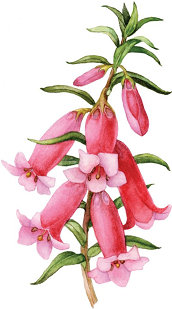How to Select the Right Plant
Plants are sensitive to the amount of sun and water they receive, the temperature, and the type of soil. When selecting plants it is essential to know the microclimates and soils across your site and choose plants which like those conditions. Failure to do so can be costly, as poorly selected plants usually die or have weak growth and few flowers.
Step 1 – Assess site conditions
Draw a sketch of your site showing its microclimates, environments and soil types
♦ What is your local climate?

Inland – hot summers
e.g. Mallee, Wimmera, North Country, Horsham, Mildura, Swan Hill, Echuca, Bendigo, Shepparton, Albury/Wodonga
Highlands – frosty winters
e.g. Hamilton, Ararat, Ballarat, Kyneton, Kilmore, Mansfield, Bright, Wangaratta
Coastal – temperate
e.g. Warrnambool, Geelong, Melbourne (most), LaTrobe Valley, Sale, East Gippsland
♦ What are the microclimates and environments across your site?
NOTE: Microclimates and environments can change dramatically even across small suburban gardens. (For example: exposed north or west facing sites are generally hot and dry; a southerly aspect cool and moist; buildings can create windy spots or channel cold, frosty air in winter).
Temperature: hot, normal, cold
Frost: frost free, light (-2 to -3°C), moderate (-4 to -5°C), heavy (> -6°C)
Light: full sun, part sun, full shade
Environment: salt spray, windy, bushfire prone area
Soil moisture: dry, normal, moist, waterlogged
♦ What soils do you have on your site?
NOTE: Soils too can change dramatically across small sites. (For example: clay sub soil might have been deposited on the top soil in a section of the site during building construction; limestone might occur in a location making the soil there alkaline)
Type: Gravel, sand, sandy loam, loam, clay loam or clay
pH: Alkaline (pH greater than 7.4), neutral (pH 6.6 – 7.3) acid (pH less than 6.5)
Step 2 – Select plants which suit both your garden design and site conditions
Now it’s time to visit your local plant nursery. Take your site sketch with you and always read the plant labels to ensure the ones you like suit your site conditions and, when they reach maturity, will have the right size and shape.
NOTE: Most Australian native plants grow rapidly, so it is often best to buy a small plant instead of a more expensive mature plant.
Tips for choosing and using plants in your garden design:
>> Further Information
Plants we recommend:
Hardy, easily grown plants >> Further Information
Drought tolerant plants for climates similar to Melbourne >> Further Information
Fire resistant and retardant plants >> Further Information
Now that you are ready to plant
Planting times for all areas of Victoria >> Further Information
Tips for growing native plants >> Further Information
ANPSA’s native plant guides >> Further Information
(For comprehensive information on the use and cultivation of many species of Australian native plants.)

